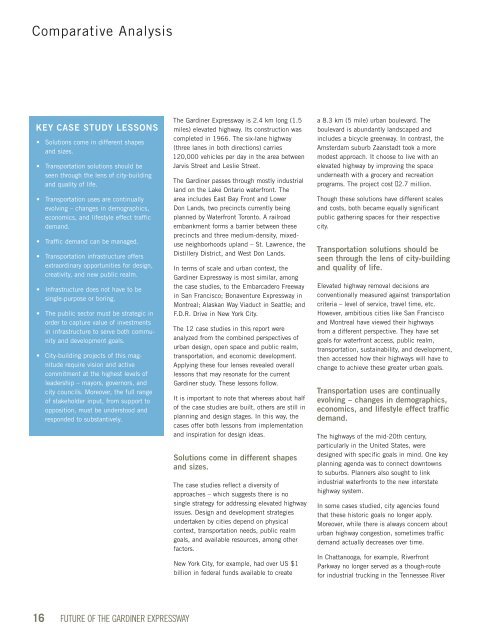Comparative AnalysisKEY CASE STUDY LESSONS• Solutions come in different shapesand sizes.• Transportation solutions should beseen through <strong>the</strong> lens <strong>of</strong> city-buildingand quality <strong>of</strong> life.• Transportation uses are continuallyevolving – changes in demographics,economics, and lifestyle effect trafficdemand.• Traffic demand can be managed.• Transportation infrastructure <strong>of</strong>fersextraordinary opportunities for design,creativity, and new public realm.• Infrastructure does not have to besingle-purpose or boring.• The public sector must be strategic inorder to capture value <strong>of</strong> investmentsin infrastructure to serve both communityand development goals.• City-building projects <strong>of</strong> this magnituderequire vision and activecommitment at <strong>the</strong> highest levels <strong>of</strong>leadership – mayors, governors, andcity councils. Moreover, <strong>the</strong> full range<strong>of</strong> stakeholder input, from support toopposition, must be understood andresponded to substantively.The <strong>Gardiner</strong> <strong>Expressway</strong> is 2.4 km long (1.5miles) elevated highway. Its construction wascompleted in 1966. The six-lane highway(three lanes in both directions) carries120,000 vehicles per day in <strong>the</strong> area betweenJarvis Street and Leslie Street.The <strong>Gardiner</strong> passes through mostly industrialland on <strong>the</strong> Lake Ontario waterfront. Thearea includes East Bay Front and LowerDon Lands, two precincts currently beingplanned by Waterfront Toronto. A railroadembankment forms a barrier between <strong>the</strong>seprecincts and three medium-density, mixeduseneighborhoods upland – St. Lawrence, <strong>the</strong>Distillery District, and West Don Lands.In terms <strong>of</strong> scale and urban context, <strong>the</strong><strong>Gardiner</strong> <strong>Expressway</strong> is most similar, among<strong>the</strong> case studies, to <strong>the</strong> Embarcadero Freewayin San Francisco; Bonaventure <strong>Expressway</strong> inMontreal; Alaskan Way Viaduct in Seattle; andF.D.R. Drive in New York City.The 12 case studies in this report wereanalyzed from <strong>the</strong> combined perspectives <strong>of</strong>urban design, open space and public realm,transportation, and economic development.Applying <strong>the</strong>se four lenses revealed overalllessons that may resonate for <strong>the</strong> current<strong>Gardiner</strong> study. These lessons follow.It is important to note that whereas about half<strong>of</strong> <strong>the</strong> case studies are built, o<strong>the</strong>rs are still inplanning and design stages. In this way, <strong>the</strong>cases <strong>of</strong>fer both lessons from implementationand inspiration for design ideas.Solutions come in different shapesand sizes.The case studies reflect a diversity <strong>of</strong>approaches – which suggests <strong>the</strong>re is nosingle strategy for addressing elevated highwayissues. Design and development strategiesundertaken by cities depend on physicalcontext, transportation needs, public realmgoals, and available resources, among o<strong>the</strong>rfactors.New York City, for example, had over US $1billion in federal funds available to createa 8.3 km (5 mile) urban boulevard. Theboulevard is abundantly landscaped andincludes a bicycle greenway. In contrast, <strong>the</strong>Amsterdam suburb Zaanstadt took a moremodest approach. It choose to live with anelevated highway by improving <strong>the</strong> spaceunderneath with a grocery and recreationprograms. The project cost €2.7 million.Though <strong>the</strong>se solutions have different scalesand costs, both became equally significantpublic ga<strong>the</strong>ring spaces for <strong>the</strong>ir respectivecity.Transportation solutions should beseen through <strong>the</strong> lens <strong>of</strong> city-buildingand quality <strong>of</strong> life.Elevated highway removal decisions areconventionally measured against transportationcriteria – level <strong>of</strong> service, travel time, etc.However, ambitious cities like San Franciscoand Montreal have viewed <strong>the</strong>ir highwaysfrom a different perspective. They have setgoals for waterfront access, public realm,transportation, sustainability, and development,<strong>the</strong>n accessed how <strong>the</strong>ir highways will have tochange to achieve <strong>the</strong>se greater urban goals.Transportation uses are continuallyevolving – changes in demographics,economics, and lifestyle effect trafficdemand.The highways <strong>of</strong> <strong>the</strong> mid-20th century,particularly in <strong>the</strong> United States, weredesigned with specific goals in mind. One keyplanning agenda was to connect downtownsto suburbs. Planners also sought to linkindustrial waterfronts to <strong>the</strong> new interstatehighway system.In some cases studied, city agencies foundthat <strong>the</strong>se historic goals no longer apply.Moreover, while <strong>the</strong>re is always concern abouturban highway congestion, sometimes trafficdemand actually decreases over time.In Chattanooga, for example, RiverfrontParkway no longer served as a though-routefor industrial trucking in <strong>the</strong> Tennessee River16<strong>Future</strong> <strong>of</strong> <strong>the</strong> <strong>Gardiner</strong> <strong>Expressway</strong>
Valley as it did in <strong>the</strong> 1960s. In fact, <strong>the</strong>parkway had excess capacity. Redesigning<strong>the</strong> road as an at-grade boulevard did not<strong>the</strong>refore produce congestion downtown.Traffic demand can be managed.The most successful highway reconfigurationprojects complement changes to expresswayfunctions with new transit infrastructureand policy. Traffic demand strategies rangefrom increased public transit to user fees forparking, from incentives for alternatives tocommuting by car to congestion pricing.Seoul, for example, complemented <strong>the</strong>demolition <strong>of</strong> <strong>the</strong> Cheonnggyecheon<strong>Expressway</strong> – which carried 120,000 vehiclesper day – with new bus rapid transit. Seattlewill add new light rail when <strong>the</strong> Alaskan WayViaduct is replaced with a tunnel. Theseimprovements not only encourage mode shift(from car to public transit, for example), butset <strong>the</strong> stage for reducing carbon emissions.Transportation infrastructure <strong>of</strong>fersextraordinary opportunities for design,creativity, and new public realm.Highway reconfiguration provides rareopportunities for cities to streng<strong>the</strong>nwaterfront connections and create new publicrealm <strong>the</strong>re. At <strong>the</strong> same time, some citieshave learned that <strong>the</strong>y need not always turn<strong>the</strong>ir back to infrastructure.New York City is developing a new publicesplanade under <strong>the</strong> elevated F.D.R. Drive inLower Manhattan. Through lighting, programdiversity, surface materials, and noiseattenuatingcladding, <strong>the</strong> space under <strong>the</strong>highway will be transformed into an inviting,active space. Moreover, innovative designwill give <strong>the</strong> East River Esplanade a uniquecharacter, making it a one-<strong>of</strong>-a-kind publicspace in <strong>the</strong> city.Infrastructure does not have to besingle-purpose or boring.Cities are transforming both de-commissionedand active infrastructure into new civiclandmarks and unexpected spaces for urbanactivity. Paris closes <strong>the</strong> Georges Pompidou<strong>Expressway</strong> in summer to create an urbanbeach along <strong>the</strong> banks <strong>of</strong> <strong>the</strong> Seine. BothParis and New York have re-imagined elevatedrailroads as linear parks. The design <strong>of</strong> <strong>the</strong>High Line in New York integrates landscapewith an iconic industrial-era elevated structure.The public sector must be strategicin order to capture value <strong>of</strong> investmentsin infrastructure to serve bothcommunity and development goals.Public investment in highway reconfigurationand removal creates benefits – fromdevelopment parcels to increased propertyvalues to improved quality <strong>of</strong> life. The publicsector must act strategically in order tocapture this value. In Montreal, for example,parcels created by removing <strong>the</strong> Bonaventure<strong>Expressway</strong> will be sold to <strong>the</strong> privatesector for mixed-use development. Highwayremoval will also enhance <strong>the</strong> value <strong>of</strong> recentredevelopment in <strong>the</strong> neighboring CiteMultimedia.Conversely, opportunity costs accumulatewhen decision-making processes drag on.In Seattle, real estate speculators acquiredproperties along <strong>the</strong> Alaskan Way Viaductduring a decade <strong>of</strong> transportation studies. Thepublic sector lost <strong>the</strong> opportunity to acquire<strong>the</strong>se properties itself, <strong>the</strong>n increase revenuethrough disposition.City-building projects <strong>of</strong> this magnituderequire vision and active commitmentat <strong>the</strong> highest levels <strong>of</strong> leadership– mayors, governors, and citycouncils. Moreover, <strong>the</strong> full range <strong>of</strong>stakeholder input, from support toopposition, must be understood andresponded to substantively.City leaders need to support and advocate forintegrated approaches to infrastructure design.Their vision must embrace <strong>the</strong> full range <strong>of</strong>urban design, public realm, transportation,and economic development opportunities.Visionary leadership is complemented by aninformed and engaged public that has anactive role in developing design solutions.The <strong>Gardiner</strong> <strong>Expressway</strong> and downtown Toronto viewed from <strong>the</strong> south-east.SECTION IV: COMPARATIVE ANALYSIS 17
- Page 1 and 2: Future of the Gardiner ExpresswayEn
- Page 3 and 4: ContentsIIntroductionII Scale Compa
- Page 6 and 7: (This page intentionally left blank
- Page 8 and 9: Scale ComparisonsA8ern8• Zaanstad
- Page 10 and 11: Scale ComparisonsGardiner Expresswa
- Page 12 and 13: Scale ComparisonsEmbarcadero Freewa
- Page 14 and 15: (This page intentionally left blank
- Page 17 and 18: The following describes additional
- Page 19: ComparativeAnalysisSECTION IV: COMP
- Page 23 and 24: Case StudiesSECTION V: Case studies
- Page 25 and 26: The Governor announced in early 200
- Page 27 and 28: West Side Highway, New York, NYRepl
- Page 29 and 30: totalling US $200 million of added
- Page 31 and 32: The City is currently reviewing the
- Page 33 and 34: Riverfront Parkway, Chattanooga, TN
- Page 35 and 36: A sweeping fly-over bridge connects
- Page 37 and 38: at-grade boulevard. The new bouleva
- Page 39 and 40: Cheonggyecheon Expressway, Seoul, K
- Page 41 and 42: Sustainability objectives guided th
- Page 43 and 44: of truck traffic, its neighborhoods
- Page 45 and 46: impact on the town fabric. A8 is a
- Page 47 and 48: the style of the Place des Vosges a
- Page 49 and 50: the same time, the Esplanade is one
- Page 51 and 52: would return US $47.5 million. Alto
- Page 53 and 54: ProcessThe Whitehurst Freeway was r
- Page 55 and 56: “Teasers” andBoulevardsSECTION
- Page 57 and 58: The High Line - New York, NY• A d
- Page 59 and 60: University Avenue - Toronto, ON•
- Page 61 and 62: Summary MatrixSECTION VII: SUMMARY
- Page 63 and 64: Urban Design Goals Open Space Goals
- Page 65 and 66: Urban Design Goals Open Space Goals
- Page 67 and 68: SourcesSECTION VIII: Sources 63
- Page 69 and 70: Office of Congressman Brian Higgins



